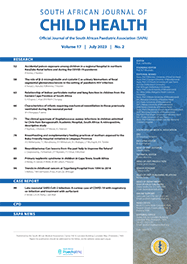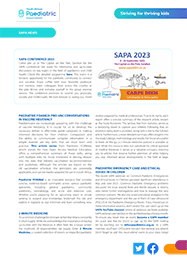Articles

Should the routine approach to diarrhoea management be modified in an area of high prevalence of paediatric HIV infection?
Abstract
Aims and methods. This was a retrospective review of patients admitted to Kalafong and Steve Biko referral hospitals to identify the impact of a high prevalence of HIV infection in the community on the routine management of diarrhoea.
Results. A total of 176 patients were included. HIV tests were performed on 99 patients, and HIV infection was therefore not considered as a co-diagnosis in 78 of 176 (44.3%) of patients with diarrhoea.
On admission, the group of children tested for HIV infection were similar to the other groups (not tested for HIV or HIV negative) in age, but showed differences in respect of duration of diarrhoea and preceding events prior to referral. More children tested for HIV infection also had clinical wasting, generalised lymphadenopathy or hepatomegaly compared with untested children (p<0.005). However, there were no differences in the proportion of tested children with prior antibiotics before referral, presence of co-morbid pneumonia or urinary infection.
Patients with diarrhoea were more likely to be tested for HIV if they were severely malnourished or clinically wasted, if they had hyponatraemia or hypokalaemia, and if they had hepatomegaly or lymphadenopathy. The presence of shock or severe dehydration on admission, or of co-morbid pneumonia, did not differentiate between those who were tested for HIV and those who were not.
There were statistically significant differences between those tested for HIV and those not tested in respect of outcome. Among the children tested for HIV, 24.2% of survivors had a prolonged hospital stay (more than 10 days), compared with 1.4% among those not tested (p<0.005). While more children in the group tested for HIV died in hospital (6.1% v. 2.6%), this did not reach statistical significance (p=0.466).
Conclusion. In this study, HIV testing was found to be predominantly based on clinical grounds at the time of admission. Because of considerable clinical overlap between diarrhoea patients with and without HIV infection, HIV co-infection cannot be reliably predicted on clinical features alone and must be actively excluded.
Effective ART is now available. All patients with diarrhoea must therefore be offered HIV testing in order to provide earlier access to appropriate management.
Authors' affiliations
A J Terblanche, Steve Biko Academic Hospital
R Netshimboni, Steve Biko Academic Hospital, University of Pretoria
D F Wittenberg, Steve Biko Academic Hospital, University of Pretoria
Keywords
Cite this article
Article History
Date published: 2012-02-24
Article Views
Full text views: 4553

.jpg)



Comments on this article
*Read our policy for posting comments here